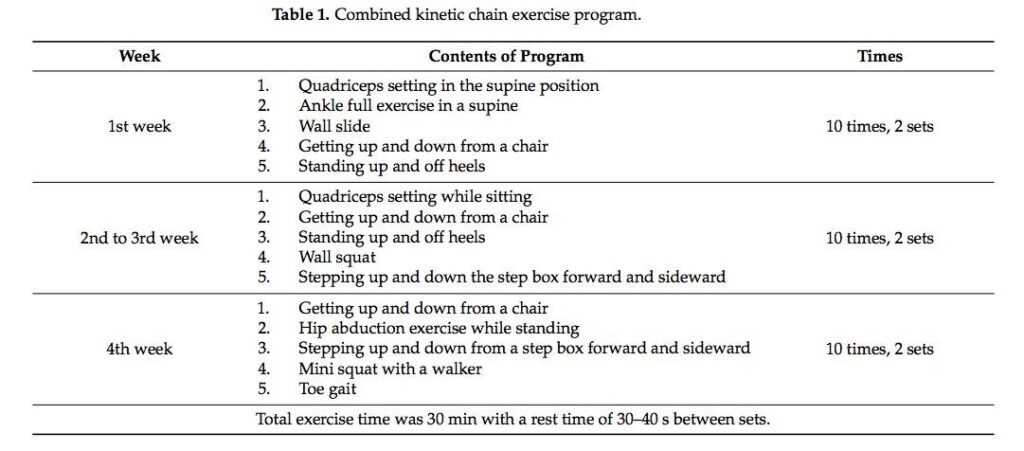The Effect of Combined Kinematic Chain Exercise on Physical Function, Balance Ability, and Gait in Patients with Total Knee Arthroplasty: A Single-Blind Randomized Controlled Trial Reviewed by: Zachary Stango, SPT; Bridget Collier, PT, DPT
Reviewed by: Zachary Stango, SPT; Bridget Collier, PT, DPT
Protocols regarding the rehab process for total knee arthroplasties (TKA) are consistently analyzed as the growing number of these surgical procedures is expected to increase with the rising population of older adults. Open chain movements, characterized by distal on proximal motion (aka, exercises in which the body part farthest from your body, usually your hand or foot, is moving and not fixed: seated leg extension machine, for example), are often utilized post-operatively to improve strength and ROM of the surrounding musculature without overloading the affected joint. Closed chain exercises, characterized by proximal on distal motion (aka, exercises in which the body part farthest from your body, usually your hand or foot, is fixed and not moving: squats, for example) can be introduced post-operatively to improve weight-bearing and proprioceptive abilities of the affected joint. The randomized controlled trial conducted by An et al. (2023) aimed to analyze the effects of incorporating combined (closed and open) kinematic chain exercises on improving physical function, balance, and gait in the early phases of rehab for individuals undergoing a total knee arthroplasty.
The inclusion criteria for this study consisted of patients aged 65 years or older who underwent a cemented TKA due to osteoarthritic changes. 40 women were randomly assigned to complete a specific kinematic intervention consisting of open or combined chain exercises for 30 minutes five times a week. The interventions were initiated the 3rd day following the surgery and lasted for 4 weeks. The individuals in the combined exercise group completed interventions targeting the hip, knee, and ankle in open and closed chain positions, while the individuals in the open exercise group solely completed the interventions without a load bearing component on the affected knee. Table 1 displays the interventions designed for the group undergoing the combined circuit of open and closed exercises.

A multitude of scales were employed to assess the metrics of this trial. To analyze the effect of the exercise programs on physical function, the trial utilized the Western Ontario and McMaster Universities Osteoarthritis Index (WOMAC), the Knee Outcome Survey-Activities of Daily Living (KOS-ADL), and range of motion measurements. To analyze balance and gait, the trial used the Zebris PDM platform which is composed of force plates that measured the amount of postural sway of the participants, as well as gait parameters like velocity, cadence, step length, and stride length. The Timed Up and Go (TUG) was also used as a tool to encompass all of the outcomes analyzed: mobility, balance, and gait. In all of the examined outcomes, the combined kinematic chain exercise group produced significant improvements compared to that of the open chain kinematic group.
Clinical Bottom Line:
The results of this trial serve as evidence suggesting the inclusion of closed kinematic chain exercises in conjunction with open kinematic chain exercises, when tolerable, as a vital part of the early phases of the rehabilitation process for patients who have undergone a TKA. The additional weight-bearing component that closed chain exercises provide can be pivotal post-operatively in training the affected joint’s sensory input and surrounding musculature, aiding in the stability of the knee. These improvements are valuable for discussions regarding the patients return to their prior level of function, as the enhancements shown in the results of this trial can be used to ultimately aspire for a reduction in falls and kinesiophobia of patients undergoing this transformative surgery.
References:
An J, Son YW, Lee BH. Effect of Combined Kinematic Chain Exercise on Physical Function, Balance Ability, and Gait in Patients with Total Knee Arthroplasty: A Single-Blind Randomized Controlled Trial. Int J Environ Res Public Health. 2023;20(4):3524. Published 2023 Feb 16. doi:10.3390/ijerph20043524
